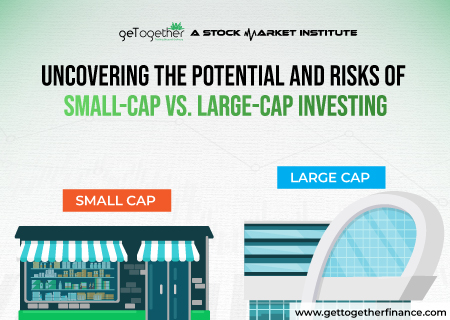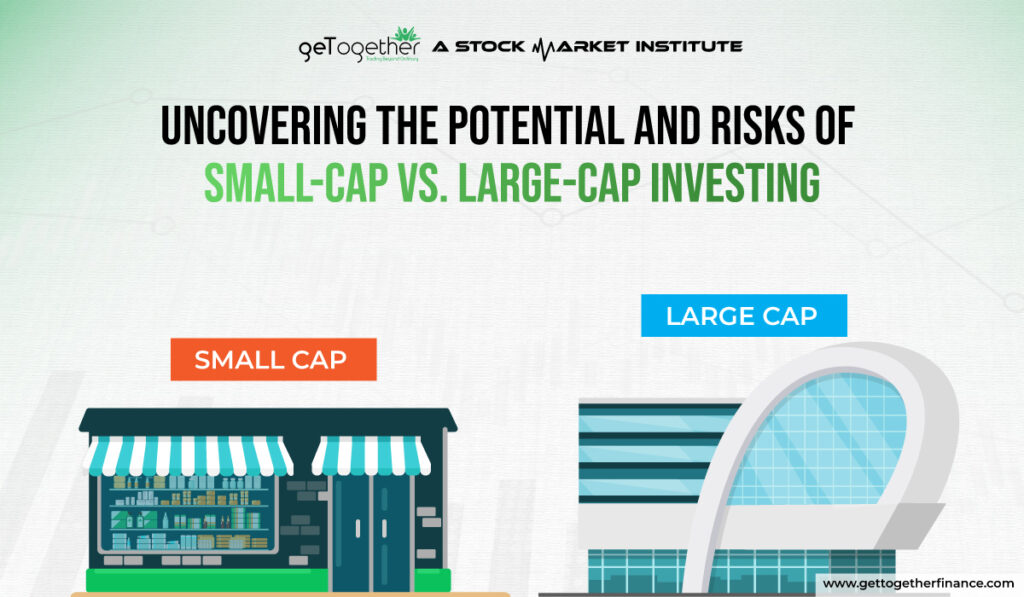Uncovering the Potential and Risks of Small-Cap vs Large-Cap Investing


Overview
The stock market is a vast ocean filled with countless investment opportunities. In this, mutual funds are considered one of the best investment ways to book good returns, offering various choices to investors, depending on risk appetite and market capitalisation.
Nowadays, two of the most commonly used terms to categorise companies in the market are “small-cap” and “Large-Cap.” These labels refer to the size of a company based on its market capitalization. But what do these terms really mean for investors? How do small-cap vs large-Cap stocks differ in terms of risk, return, and suitability?
In this blog, we will take a deep plunge into the world of small-cap and large-Cap stocks, including their basic fundamentals, differences, and list of small and large-Cap stocks in the market. So let’s begin with.
What is Market Capitalisation?

Market capitalisation, often referred to as market cap, is a measure of a company’s total value as determined by the stock market. It is calculated by multiplying the current share price of the company by its total number of outstanding shares.
The formula for market capitalisation is:
Market Capitalisation = Share Price × Total Number of Outstanding Shares
For example, if a company has 1 million shares outstanding and the current share price is ₹50, the market capitalisation would be:
Market Capitalisation = 1,000,000 × 50 = ₹50,000,000
Also Read: Company Valuation
Types of Market Capitalisations

There are three types of market capitalisation:
- Large-Cap
- Mid-Cap
- Small-Cap
But what do these terms mean, and how do these companies differ? In 2017, the Securities and Exchange Board of India (SEBI) introduced specific regulations to categorise companies based on their market capitalisation.
Market capitalisation, or market cap, categorises companies based on their total market value. This classification helps investors understand the size, stability, and growth potential of different companies. There are three primary types of market capitalisation:
Large Cap Stocks
Large Cap companies are well-established firms with a market capitalisation of ₹20,000 crore or more. These companies are usually well-established and have a significant presence in their industry. Here let’s discuss some traits of large Cap companies:
Characteristics of Large Cap Stocks
- Stability: These companies are generally stable with a long track record of performance.
- Lower Risk: They tend to have less volatility compared to smaller companies.
- Dividends: Often pay regular dividends to their shareholders.
- Examples: Reliance Industries, Tata Consultancy Services (TCS), and HDFC Bank.
Mid-Cap Stocks
Mid-cap companies have a market capitalisation between ₹5,000 crore and ₹20,000 crore. These companies occupy the middle ground between large Cap and small-cap stocks, offering a unique blend of characteristics that can make them attractive to a wide range of investors. Let’s break down the details:
Characteristics of Mid Cap Stocks:
- Growth Potential: These companies offer significant growth potential as they are often in the expansion phase.
- Moderate Risk: They are more volatile than large Cap companies but less so than small-cap companies.
- Investment Appeal: Attractive to investors looking for a balance between stability and growth.
- Examples: Voltas, MRF, and Havells India.
Small-Cap Stocks
Small-cap companies have a market capitalisation below ₹5,000 crore. These companies are typically younger and smaller compared to their large Cap and mid-cap counterparts. Here are some basic characteristics:
Characteristics of small cap stocks
- High Growth Potential: These companies can offer high returns as they are often newer and growing rapidly.
- High Risk: They are more volatile and carry higher risk due to their size and market position.
- Innovation: Often at the forefront of innovation and new market trends.
- Examples: Ashok Leyland, SpiceJet, and Future Retail.
Difference between Small-Cap vs Large-Cap Stocks

But what is the difference between small-cap and large Cap stocks? Let’s figure out Small-Cap vs large-Cap in simplified way:
| Feature | Large-Cap Companies | Small-Cap Companies |
| Market Capitalisation | ₹20,000 crore or more | Below ₹5,000 crore |
| Stability | High | Low |
| Risk | Low | High |
| Growth Potential | Limited | High |
| Dividends | Often pay regular dividends | Less likely to pay dividends |
| Liquidity | High | Low |
| Investor Confidence | High | Variable |
| Examples | Reliance Industries, Tata Consultancy Services (TCS), HDFC Bank | Ashok Leyland, SpiceJet, Future Retail |
| Investment Appeal | Reliable returns, lower risk, steady growth | Potential for higher returns, opportunities in emerging markets and sectors, high innovation and dynamism |
| Information Availability | High | Low |
| Volatility | Low | High |
| Sector Presence | Often diversified across multiple sectors | Often niche or emerging sectors |
Small-Cap vs Large-Cap Stocks

Here is a list of Large-Cap and small-cap stocks that are leading in the Indian market:
| Sector | Small-Cap Stocks | Market Cap Type | Large-Cap Stocks | Market Cap Type |
| Technology | Happiest Minds Technologies | Small-Cap | Tata Consultancy Services | Large-Cap |
| Coforge | Small-Cap | Infosys | Large-Cap | |
| Persistent Systems | Small-Cap | HCL Technologies | Large-Cap | |
| Healthcare | Laurus Labs | Small-Cap | Sun Pharmaceutical Industries | Large-Cap |
| Biocon | Small-Cap | Dr. Reddy’s Laboratories | Large-Cap | |
| Alkem Laboratories | Small-Cap | Apollo Hospitals Enterprise | Large-Cap | |
| Consumer Discretionary | Relaxo Footwears | Small-Cap | Maruti Suzuki India | Large-Cap |
| Crompton Greaves Consumer Electricals | Small-Cap | Hindustan Unilever | Large-Cap | |
| Bata India | Small-Cap | Titan Company | Large-Cap | |
| Financials | Equitas Small Finance Bank | Small-Cap | HDFC Bank | Large-Cap |
| Ujjivan Small Finance Bank | Small-Cap | ICICI Bank | Large-Cap | |
| Shriram Transport Finance | Small-Cap | State Bank of India | Large-Cap | |
| Industrials | Bharat Forge | Small-Cap | Larsen & Toubro | Large-Cap |
| Thermax | Small-Cap | Adani Ports and Special Economic Zone | Large-Cap | |
| Timken India | Small-Cap | Siemens | Large-Cap |
To Sum Up
Understanding Large-Cap (Big Cap) and small-cap stocks is crucial for any investor. Large-Cap stocks belong to well-established companies with a high market value, offering stability and lower risk, but with limited rapid growth. On the other hand, small-cap stocks are from smaller, newer companies that have the potential for high growth but come with higher risk and more volatility.
Investing in Large-Cap stocks can be a good choice if you seek steady returns and lower risk. Small-cap stocks, however, are ideal if you are willing to take on more risk for the chance of higher returns. By diversifying your investments across both Large-Cap and small-cap stocks, you can balance stability with growth potential, aligning with your financial goals and risk tolerance.
FAQs
Can I invest in both small-cap and large Cap stocks?
Yes, diversifying your portfolio across different cap sizes can help manage risk.
Which is better: small-cap or large Cap stocks?
Both have pros and cons. Small-caps offer higher growth potential but more risk, while Large Caps are generally stable but with lower growth potential. The choice depends on your financial goals and risk tolerance.
What is the best time to invest in small-cap stocks?
Small-caps often perform well during economic upturns, but past performance is not indicative of future results.
Can I invest in small-cap stocks with a small amount of money?
Yes, you can start with a small amount through mutual funds or direct stock purchases.



 Facebook
Facebook  Instagram
Instagram  Youtube
Youtube 
